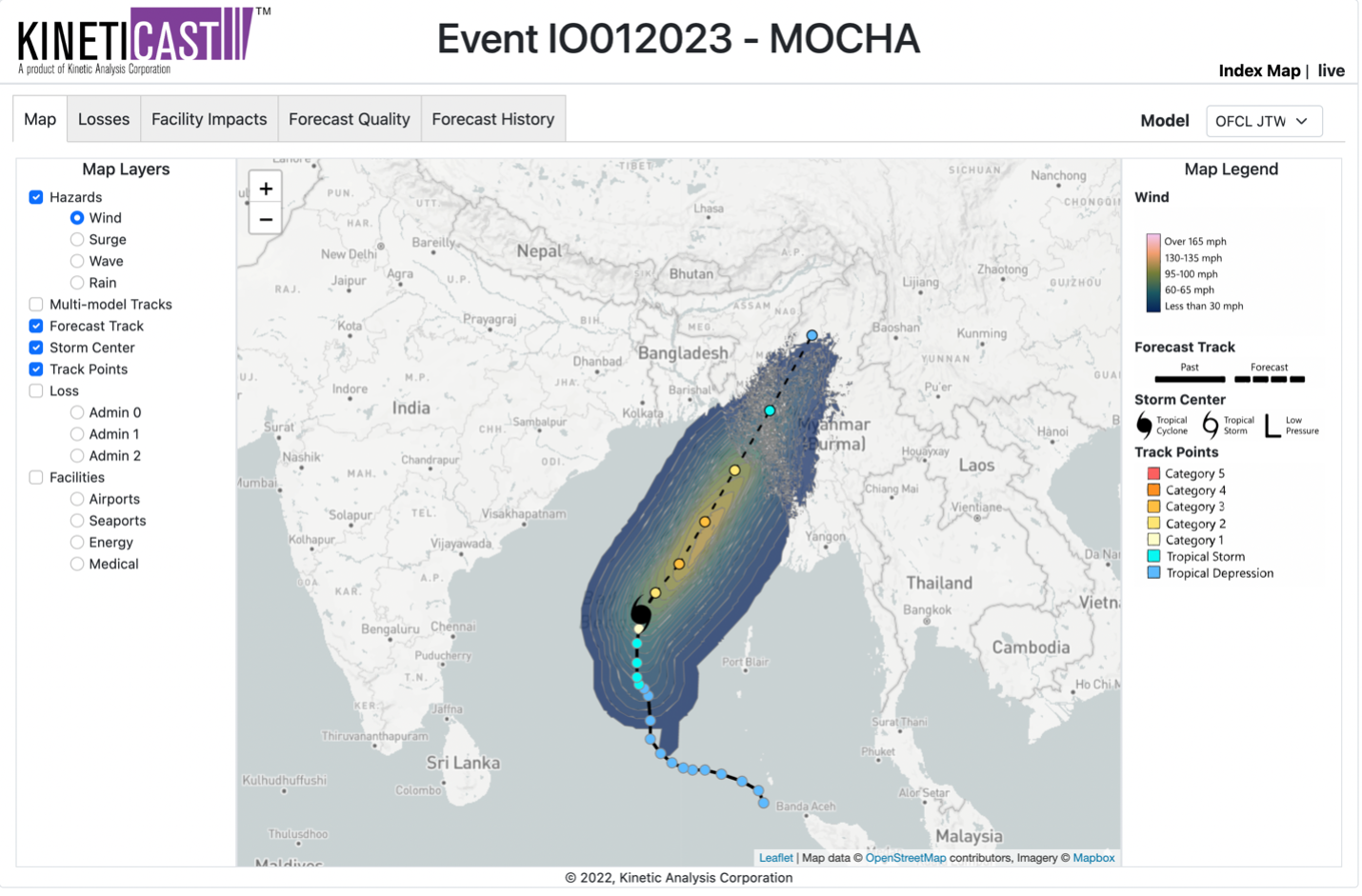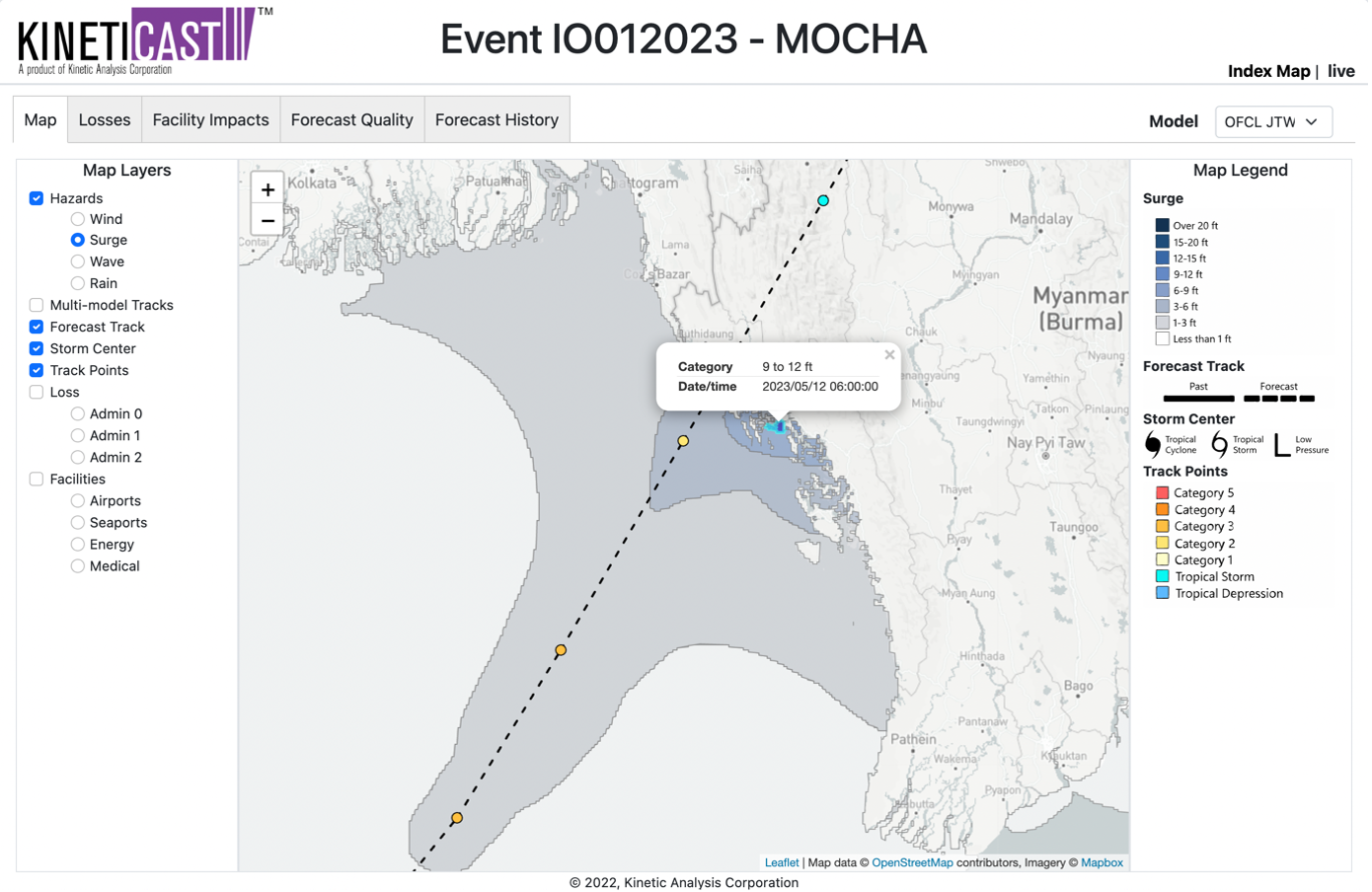Devastating Storm Approaches Myanmar/Bangladesh: Tropical Cyclone Mocha Forms in the Bay of Bengal
The North Indian Ocean tropical cyclone season has officially kicked off. The first storm of the season, Tropical Cyclone Mocha, formed into a deep depression on May 10 before being upgraded to a cyclonic storm on May 11 [1]. The cyclone, which received its name after the port city in Yemen known for its coffee production – Mokha – is projected to intensify into a severe tropical cyclone in the next couple of days while it traverses sea surface temperatures greater than 30-31 degrees Celsius (86-88 degrees Fahrenheit) [1, 2].
Projected wind swath of Tropical Cyclone Mocha, generated by KinetiCast™ models using forecast data from the Joint Typhoon Warning Center (JTWC). The filled in circles represent the past/forecast path of the cyclone color-coded by intensity.
Current surface temperature chart (°C) from Tropical Tidbits [3].
As displayed in the forecast graphic, Mocha is expected to intensify into a category 3-equivalent tropical cyclone while it heads to the north and east. It’s important to note that this forecast could be conservative as there is limited skill in forecasting storm intensity. Regardless of the exact intensity of the storm during landfall, the impacts are likely to be devastating. The International Refugee Committee warns that Mocha is approaching Cox’s Bazar refugee camp where there are over a million Rohingya people [4].
Based on current JTWC forecasts, KinetiCast™ estimates there could be over 3 meters of storm surge. One factor contributing to the significant storm surge is the concave shape of the coastline between eastern Indian and Myanmar. In general, storm surge tends to be higher for a concave as opposed to a convex or regular-shaped coastline [5]. The bay is also wider on its southern flank and narrower on its northern flank, which results in a funneling of water as systems move to the north [6]. As one heads on land, they will find that the land mass is largely comprised of a flat plain along with several major river deltas [6]. All these factors combine to produce large storm surges in the region.
Projected storm-surge for Tropical Cyclone Mocha as it approaches the coast. Numbers shown are a combination of storm-induced sea level rise and tides.
Aside from geographical effects, Mocha is a very large system, with its cloud decks spanning almost the entire width of the Bay of Bengal, or roughly 1,000 miles in diameter [1]. This means that effects from rainfall-induced flooding will likely be catastrophic. There’s also the complex interplay between natural hazards and the socioeconomic factors of the region to consider. The northern Bay of Bengal has one of the highest population densities anywhere on the planet [4]. This factor contributes to landfalling systems in the region being some of the deadliest in the world. In fact, Roxy Mathew Koll, a climate scientist at the Indian Institute of Tropical Meteorology, observed that while “the Bay of Bengal hosts only 4% of the total tropical cyclones globally,” the region accounts for more than 80% of fatalities from tropical cyclones [7].
In this instance, another relevant factor is the ongoing civil war in Myanmar. At the present time, nearly 2 million are displaced internally and another 1 million are considered refugees [8], which means these particularly vulnerable populations are likely to come under the risk of high winds, devastating storm surge, and heavy rainfall. This is exacerbated by the reality that the Bangladesh border has historically been an active spot for conflict, and several large camps host many of these displaced persons [9].
Tropical Cyclone Mocha is an event that bears watching closely. Indeed, the hurricane season in the Northern Hemisphere is set to begin in earnest over the next few months. At Kinetic Analysis Corporation, we pride ourselves in being the leading provider of tropical cyclone hazard and impact information for events around the globe. We provide this data at the national level as well as for counties, districts, and cities. Our web app, KinetiCastTM, helps you closely monitor the storm in real-time with sources of data ranging from forecast quality, model comparison, and facility impacts all in one location. No more having to keep 10 webpages open to access all the information you need! If you would like to know more about the data we offer and our subscription plans, please reach out to aagastra@kinanco.com.
References:
1. https://www.accuweather.com/en/hurricane/bangladesh-myanmar-bracing-for-life-threatening-cyclone-mocha/1526006
2. https://www.ndtv.com/india-news/cyclone-mocha-all-you-need-to-know-about-depression-over-bay-of-bengal-4024402
3. https://www.tropicaltidbits.com/analysis/ocean/cdas-sflux_sst_io_1.png
4. https://www.rescue.org/press-release/bangladesh-irc-warns-over-850000-rohingya-refugees-are-risk-if-cyclone-mocha-reaches
5. https://www.nhc.noaa.gov/surge/surge_intro.pdf
6. https://www.sciencedirect.com/science/article/abs/pii/S2352485520306046
7. https://weather.com/en-IN/india/news/news/2021-05-26-cyclone-yaas-history-bay-of-bengal-storms-80-cyclone-related-deaths
8. https://reporting.unhcr.org/document/4813
9. https://www.cnn.com/2023/05/12/asia/cyclone-mocha-bangladesh-myanmar-intl-hnk/index.html



